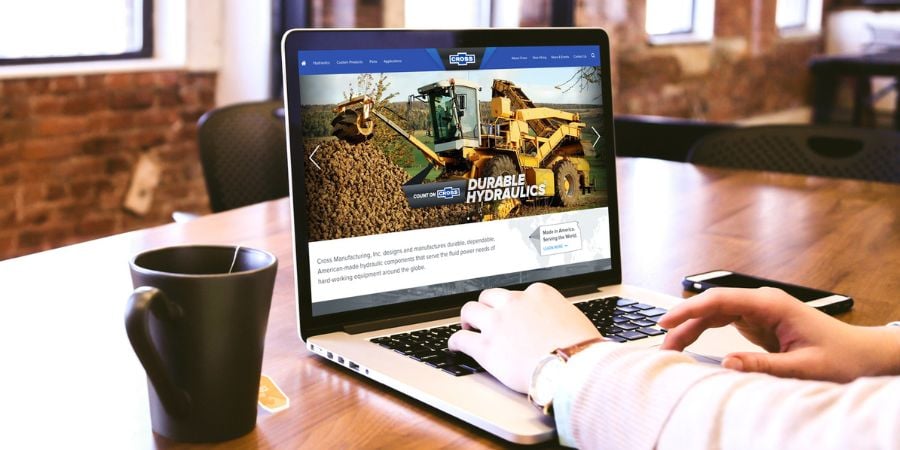Revamping Websites: Top 5 Secrets to Consider in a Website Redesign
 Krista
|
Krista
|

No one should underestimate the power of a good website: they're instrumental in helping prospective and returning clients understand your brand, find what they need, and connect with your business. So, it's no surprise that redesigning your website is something significant you should invest resources in to ensure its success.
Website redesigns will help maintain and improve your brand perception, modernizing your business and showing your customers the modernized version of your website vs. the outdated version you may have now. It also shows you care about the user experience, as recently redesigned websites usually have better functionalities. This will improve confidence in your brand and make it easier for customers to engage with you.
But most importantly, a well-optimized website helps your manufacturing business stay competitive in the digital age. It's easier to stay on pace with industry trends while outperforming your competitors if you have a website that provides a seamless online experience compared to others in your field.
So, what do you need to keep in mind when redesigning your website? Here are some tips to help you make the most of your website redesign.
1. Setting Clear Goals
Your first step in a website revamp should be asking yourself this vital question: what are your goals with your website? Having this discussion with yourself or your team will help you have a clear sense of purpose that will inform your decisions in the future. It also helps keep things like design elements cohesive between the design and development teams.
You'll also want to set objectives for your website. You want to track where you're at with benchmarks and key performance indicators (KPI) and think about what thresholds you want to achieve. A data-driven approach can help you hone in on specific parts of the website and keep the focus on areas that need the most attention.
The last goal you should always consider is your return on investment (ROI). A website revamp is an investment, so you want to ensure you get what you pay for. The more precise your objectives are, the easier it is to prioritize your resources and allocate them to the right places. This way, the project isn't aimlessly hemorrhaging money on design elements that don't align with your goals.
2. Product Visualization
Product visualization is an essential part of a website, so it will play a critical role in your website redesign. It's particularly essential for manufacturing sites, where images, 3D models, and interactive features can help clients understand the product in a holistic way.
Enhanced engagement is one of the lesser-known benefits of focusing on product visualization, especially in the modern age. Interactive features like 360-product views or product configurations automatically make your website more engaging and improve the shopping experience for the customer. It also gives them more confidence when examining the item to their specifications, as it lets them toy with the parameters to ensure they're getting exactly what they need.
An unexpected benefit is that this can also lead to fewer returns. When websites have accurate, specific portrayals of an item, customers are less likely to buy the wrong thing. This leads to enhanced customer satisfaction and the likelihood that they'll shop with you again. For those who like to share with others or leave reviews, customer satisfaction can strengthen your brand reputation and boost your sales.
3. Product Specifications
Enabling your customers to make an informed decision isn't just about securing your bottom line; it's also about providing value and establishing trust with your base. Customers are less likely to get confused when you have easy-to-find and understand features or dimensions. This can also lead to fewer questions clogging customer service queues, immediately freeing up your customer care team and improving their performance or response times.
Product specifications also make comparison much more manageable. A side-by-side comparison helps customers evaluate their options in a user-friendly way. Websites that do this effectively boost engagement and customer satisfaction since it's an essential part of the shopping experience for many in the manufacturing sector.
One of the reasons this is so important for B2B manufacturing is that they can assess a product's compatibility with their existing systems or equipment. The new product they're eyeing needs to work with the operation they already have, so a website that makes it easy for them to determine will be extremely valuable.
4. Request for Quote (RFQ) Functionality
RFQ functionality is an enormous opportunity cost for B2B manufacturers. Transactions between these businesses can often be complex, with custom orders, bulk purchases, or long-term contracts being the norm. If potential buyers have a simple way to request quotes for more unique orders, they will likely continue expressing interest in working with a business. The goal should be making the deal efficient for both parties and, as always, an enhanced customer experience.
RFQ functionality also helps with lead generation and data collection. Customers who can quickly find where to request a quote are much more likely to do so. Even if these individuals don't purchase a product, it's still valuable information that can inform everything from marketing techniques to future project offerings.
Some of the best ways you can create an efficient RFQ system are also the most obvious; the primary goal is to always simplify the quote process by:
- Designing clear and user-friendly forms that are fast to complete
- Minimizing the number of fields required to encourage more submissions
- Setting up automated responses and acknowledgments that include estimated timeframes for the customer to receive the quote.
- Integrating the RFQ system with your customer relationship management (CRM) software to capture data more efficiently
- Considering a configure-price-quote (CPQ) system if you sell complex or customizable products
Even just one of these optimizations can enormously affect how many leads you generate. And the deeper your pool of leads is, the higher your chances of successfully securing a sale.
5. Content Marketing and Thought Leadership
Content marketing and thought leadership are ways you can demonstrate value to your customers in a way that doesn't come from selling products. It also shows that you keep up with industry trends and position yourself as an industry expert. You'll gain credibility with your client base by creating and sharing information within your industry.
Educating customers with your content is also imperative in B2B manufacturing. Many products are highly complex, which can cause some potential clients to shy away from purchasing them. Making easy-to-find content that shows them how approachable the product is through tutorials and guides is a pivotal way to ensure customer satisfaction when they purchase your products.
Web design that emphasizes content creation can also improve lead generation. Content marketing can address pain points or challenges, nurturing leads and potentially converting them into loyal customers. The best way to foster these connections is by consistently creating value by sharing:
- Whitepapers and research reports that delve into best practices and industry trends
- Case studies that offer real-world examples of successful projects or partnerships with other businesses
- Resources and how-to guides that provide step-by-step instructions for your products
Using website design to showcase this content properly is crucial to improving engagement with your website. And ultimately, it will just be another way you show your customers that the customer experience is meaningful to you.
Reconsider Your Website Revamp With These Points In Mind
Consider each of these elements during your website redesign efforts, and you'll have a much higher chance of seeing a positive outcome with a high ROI. Brand recognition and customer retention should always be at the forefront of any adjustments you make. Set clear goals for yourself, focus on helping visitors understand your products and how they operate, and, above all else, improve their experience so they'll be back for more.
Subscribe to Our Blog
Stay up to date with the latest marketing, sales, and service tips.

